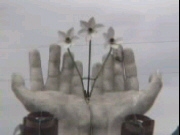The New Kurdistan
 Kurdistan is blossoming - but it depends on protection from the US and UK. The new found security is fragile, and the second Gulf War could undermine everything.
Kurdistan is blossoming - but it depends on protection from the US and UK. The new found security is fragile, and the second Gulf War could undermine everything.
A deformed baby screams for its mother in the hospital in Halabja – a living legacy of the long term effects of Saddam Hussein’s weapons of mass destruction. Today, congenital abnormality rates are 4-5 times higher than post atomic populations of Hiroshima and Nagasaki. 5000 Kurds were killed by chemical weapons in 1988, as Saddam bombed, burned and bulldozed in his attempts to exterminate the Kurds. Now they have rebuilt 80% of their villages, and Iraqi Kurdistan is undergoing a mini boom. Western style shopping malls are springing up, university students have 50 independent newspapers and internet access. ”It really is a tremendous change. We have suffered a lot. We are very happy,” comments one shopper. The Kurds see themselves as a model for a democratic Iraq. In 1992, they held elections, formed a parliament and have embraced the ballot box. ”To see what we have achieved in a situation where we had no culture of democracy and civil institutions is a great success story,” comments Salah Barham of the Kurdish regional government. But the society they have built is incredibly fragile. Saddam has 200.000 troops stationed only 30km away and security depends on the US and UK maintaining no fly zones. Gruesome pictures of 20 decapitated Kurdish fighters near the Iranian border reveals a new immediate threat ; Jund al-Islam – part of the Al Qaeda network. If President Bush is looking for evidence to link Saddam to Bin Laden, then he might find some here.
FULL SYNOPSIS

